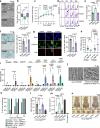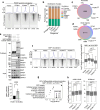O-GlcNAcylation of FOXK1 co-opts BAP1 to orchestrate the E2F pathway and promotes oncogenesis
- PMID: 40593803
- PMCID: PMC12219458
- DOI: 10.1038/s41467-025-61022-7
O-GlcNAcylation of FOXK1 co-opts BAP1 to orchestrate the E2F pathway and promotes oncogenesis
Abstract
The E2F transcription factors constitute a core transcriptional network that governs cell division and oncogenesis in multi-cellular organisms, although their molecular mechanisms remain incompletely understood. Here, we show that elevated expression of the transcription factor FOXK1 promotes transcription of E2F target genes and cellular transformation. High expression of FOXK1 in patient tumors is also strongly correlated with E2F gene expression. Mechanistically, we demonstrate that FOXK1 is O-GlcNAcylated, and loss of this modification impairs FOXK1 ability to promote cell proliferation and tumor growth. We also show that expression of FOXK1 O-GlcNAcylation-defective mutants results in reduced recruitment of the H2AK119 deubiquitinase and tumor suppressor BAP1 to E2F target genes. This event is associated with a transcriptional repressive chromatin environment and reduced cell proliferation. Our results define an essential role of FOXK1 O-GlcNAcylation in co-opting the tumor suppressor BAP1 to promote cancer cell progression through orchestration of the E2F pathway.
© 2025. The Author(s).
Conflict of interest statement
Competing interests: The authors declare no competing interests.
Figures








Update of
-
O-GlcNAcylation of FOXK1 orchestrates the E2F pathway and promotes oncogenesis.bioRxiv [Preprint]. 2024 Mar 1:2024.03.01.582838. doi: 10.1101/2024.03.01.582838. bioRxiv. 2024. Update in: Nat Commun. 2025 Jul 1;16(1):5959. doi: 10.1038/s41467-025-61022-7. PMID: 38463952 Free PMC article. Updated. Preprint.
Similar articles
-
O-GlcNAcylation of FOXK1 orchestrates the E2F pathway and promotes oncogenesis.bioRxiv [Preprint]. 2024 Mar 1:2024.03.01.582838. doi: 10.1101/2024.03.01.582838. bioRxiv. 2024. Update in: Nat Commun. 2025 Jul 1;16(1):5959. doi: 10.1038/s41467-025-61022-7. PMID: 38463952 Free PMC article. Updated. Preprint.
-
Tumor-derived neomorphic mutations in ASXL1 impairs the BAP1-ASXL1-FOXK1/K2 transcription network.Protein Cell. 2021 Jul;12(7):557-577. doi: 10.1007/s13238-020-00754-2. Epub 2020 Jul 18. Protein Cell. 2021. PMID: 32683582 Free PMC article.
-
A mutant ASXL1-BAP1-EHMT complex contributes to heterochromatin dysfunction in clonal hematopoiesis and chronic monomyelocytic leukemia.Proc Natl Acad Sci U S A. 2025 Jan 7;122(1):e2413302121. doi: 10.1073/pnas.2413302121. Epub 2025 Jan 3. Proc Natl Acad Sci U S A. 2025. PMID: 39752521 Free PMC article.
-
Different prognostic roles of tumor suppressor gene BAP1 in cancer: A systematic review with meta-analysis.Genes Chromosomes Cancer. 2016 Oct;55(10):741-9. doi: 10.1002/gcc.22381. Epub 2016 Jul 7. Genes Chromosomes Cancer. 2016. PMID: 27223342
-
Not Just PA28γ: What We Know About the Role of PA28αβ in Carcinogenesis.Biomolecules. 2025 Jun 16;15(6):880. doi: 10.3390/biom15060880. Biomolecules. 2025. PMID: 40563520 Free PMC article. Review.
References
-
- Polager, S. & Ginsberg, D. E2F - at the crossroads of life and death. Trends Cell Biol.18, 528–535 (2008). - PubMed
-
- Fischer, M., Schade, A. E., Branigan, T. B., Muller, G. A. & DeCaprio, J. A. Coordinating gene expression during the cell cycle. Trends Biochem. Sci.47, 1009–1022 (2022). - PubMed
-
- Matthews, H. K., Bertoli, C. & de Bruin, R. A. M. Cell cycle control in cancer. Nat. Rev. Mol. Cell Biol.23, 74–88 (2022). - PubMed
-
- Kent, L. N. & Leone, G. The broken cycle: E2F dysfunction in cancer. Nat. Rev. Cancer19, 326–338 (2019). - PubMed
-
- Tsai, K. L. et al. Crystal structure of the human FOXK1a-DNA complex and its implications on the diverse binding specificity of winged helix/forkhead proteins. J. Biol. Chem.281, 17400–17409 (2006). - PubMed
MeSH terms
Substances
Grants and funding
- R01 GM129325/GM/NIGMS NIH HHS/United States
- MOP159539/Gouvernement du Canada | Canadian Institutes of Health Research (Instituts de Recherche en Santé du Canada)
- PLL-192254/Gouvernement du Canada | Canadian Institutes of Health Research (Instituts de Recherche en Santé du Canada)
- PJT-195721/Gouvernement du Canada | Canadian Institutes of Health Research (Instituts de Recherche en Santé du Canada)
LinkOut - more resources
Full Text Sources

